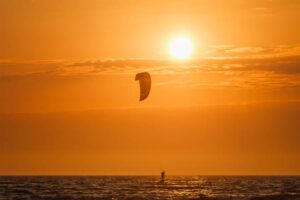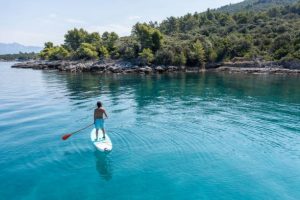Kite foiling, an exhilarating water sport, has been gaining popularity worldwide for its blend of thrill and serenity. Among the pristine waters and breathtaking landscapes of New Zealand, kite-filing enthusiasts find an ideal playground. In this article, we delve into the world of kite foiling in New Zealand, exploring its allure, locations, and the essential aspects that make it an unforgettable experience. For more information about the beginners kite foiling, click here.
The Appeal of Kite Foiling:
Kite foiling offers a unique experience of gliding effortlessly above the water, propelled by the wind and the lift generated by a hydrofoil attached to the bottom of a kiteboard. This combination of wind power and hydrodynamics allows riders to achieve remarkable speeds and unparalleled maneuverability, all while feeling a profound connection with nature.
New Zealand’s Varied Terrain:
 New Zealand’s diverse landscape provides a playground for kite foilers of all levels. From the rugged coastlines of the North Island to the fjords and bays of the South Island, there’s a spot for every preference and skill level. Auckland’s Hauraki Gulf, with its consistent winds and stunning views of the city skyline, is a favourite among locals and visitors alike. Further south, the turquoise waters of Queenstown’s Lake Wakatipu offer a picturesque setting surrounded by snow-capped peaks, providing an unforgettable backdrop for kite-filing adventures.
New Zealand’s diverse landscape provides a playground for kite foilers of all levels. From the rugged coastlines of the North Island to the fjords and bays of the South Island, there’s a spot for every preference and skill level. Auckland’s Hauraki Gulf, with its consistent winds and stunning views of the city skyline, is a favourite among locals and visitors alike. Further south, the turquoise waters of Queenstown’s Lake Wakatipu offer a picturesque setting surrounded by snow-capped peaks, providing an unforgettable backdrop for kite-filing adventures.
Ideal Conditions for Kite Foiling:
The success of a kite foiling session often hinges on favourable wind and water conditions. In New Zealand, the prevailing westerly winds ensure consistent airflow along the coastlines, creating optimal conditions for kite foiling enthusiasts. The summer months, from December to February, typically offer the best weather for kite foiling, with warm temperatures and reliable winds attracting riders from around the world. However, enthusiasts can enjoy kite foiling year-round in certain regions, thanks to New Zealand’s varied climate and microclimates. For more information about the beginners kite foiling, click here.
Safety Considerations:
While kite foiling is undeniably thrilling, safety should always be a top priority. Beginners should seek instruction from certified instructors to learn the fundamentals of kite control and foiling techniques. Additionally, wearing appropriate safety gear, such as helmets and impact vests, can mitigate the risks associated with this high-speed sport. Familiarizing oneself with local regulations and respecting other water users’ space is also crucial for a safe and enjoyable experience.
Community and Culture:
Kite foiling fosters a vibrant community of enthusiasts who share a passion for the sport and the great outdoors. In New Zealand, this community is characterized by its welcoming atmosphere and spirit of camaraderie. Whether participating in local competitions, attending kite festivals, or simply sharing tips and stories with fellow riders, kite foiling enthusiasts in New Zealand find a sense of belonging and shared purpose that enriches their experience both on and off the water.
Environmental Conservation:
As stewards of the ocean and its surrounding ecosystems, kite foiling enthusiasts in New Zealand are increasingly mindful of their environmental impact. Organizations and initiatives dedicated to marine conservation and sustainability play a vital role in preserving the natural beauty that makes New Zealand’s waters so unique. From beach cleanups to advocacy for responsible tourism practices, kite foilers are actively engaged in efforts to protect the environment for future generations of riders to enjoy.
Exploring New Zealand’s Kite Foiling Hotspots
New Zealand’s diverse coastline offers a plethora of kite-filing hotspots waiting to be explored. From the wild west coast beaches of Raglan to the tranquil harbours of Auckland, each location has its unique charm and appeal. Raglan, renowned for its consistent wind and long sandy beaches, is a favourite among kite foilers seeking epic wave riding conditions. In contrast, Auckland’s Hauraki Gulf provides a stunning backdrop of islands and volcanic cones, creating a breathtaking setting for a day on the water. Whether you’re seeking adrenaline-fueled adventures or leisurely cruises, New Zealand’s kite-filing hotspots promise unforgettable experiences for riders of all levels. So grab your gear and embark on a journey to discover the beauty and excitement of kite foiling in New Zealand’s stunning coastal playgrounds. For more information about the beginners kite foiling, click here.
Conclusion:
Kite foiling offers an unparalleled opportunity to experience the beauty and excitement of New Zealand’s coastal waters. With its diverse terrain, favourable weather conditions, and vibrant community of enthusiasts, New Zealand stands out as a premier destination for kite-filing adventures.
 There are several different types of iSUPs or inflatable standup paddle boards. Some are best used for surfing or touring, while others are more versatile for general use. There is a board out there that will work for everyone. Here are some tips for choosing the best iSUP for you. Choose a model that’s easy to learn how to paddle and performs well in most conditions.
There are several different types of iSUPs or inflatable standup paddle boards. Some are best used for surfing or touring, while others are more versatile for general use. There is a board out there that will work for everyone. Here are some tips for choosing the best iSUP for you. Choose a model that’s easy to learn how to paddle and performs well in most conditions.

